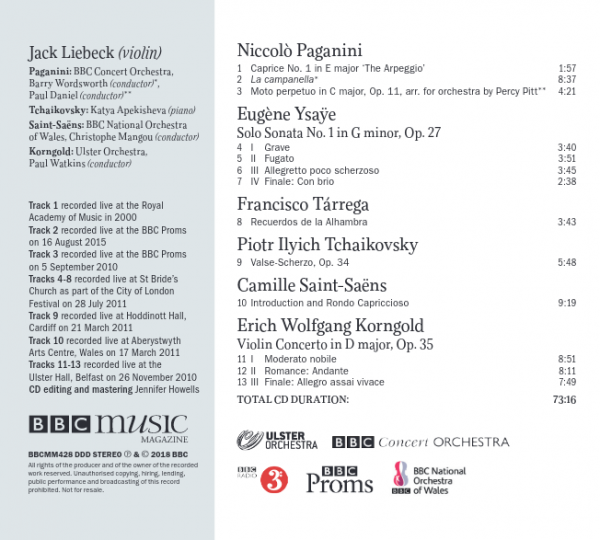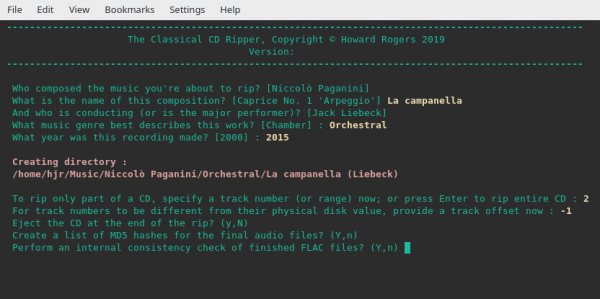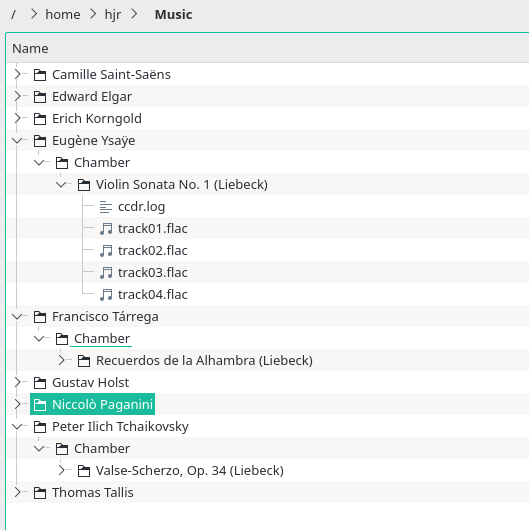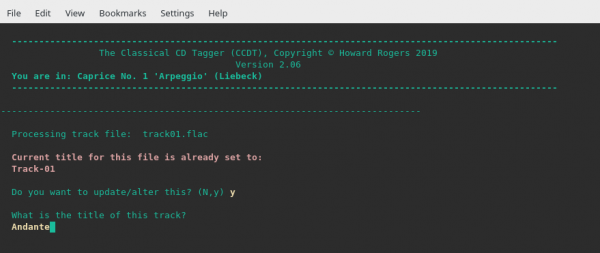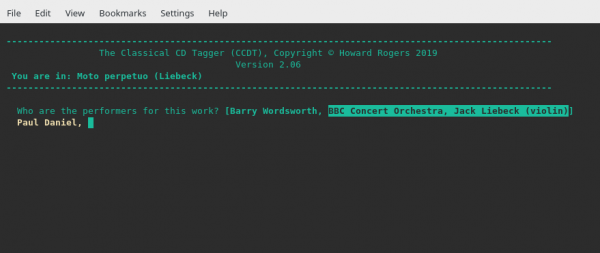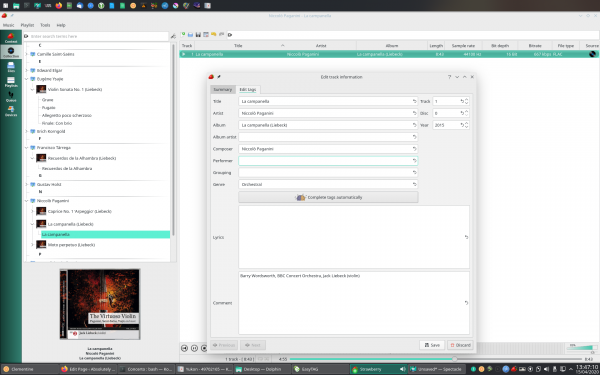1.0 Introduction
This is the fourth article in my series showing how I would suggest you go about the business of ripping and tagging different CDs of varying configurations. Previously, I’ve discussed:
- ripping 1 CD containing 1 composition by a single composer
- ripping 1 CD containing 2 compositions by a single composer
- ripping 1 CD containing multiple compositions by a single composer
In this article, I’m going to discuss how I might go about ripping a single CD containing multiple compositions by multiple composers. In particular, I’m going to discuss how to rip this album:
It's the cover CD from a BBC Music Magazine and it contains the following music:
The first thing we notice about this is that it contains the work of six different composers. My first reaction when I see these sorts of CDs is to run for the hills: you invariably find that the only 'common thread' holding all these disparate compositions together on the one CD is that it's a sort of 'Best of Karajan' or (as in this case) 'The Best of Jack Liebeck, violinist'. CDs that focus on the performing artist, rather than a composer, are generally not to my taste (because, with no disrespect intended to Mr. Liebeck, I couldn't really care too much which particular violinist was playing this sort of music: I wouldn't be able to tell them apart if it wasn't printed on the CD cover, after all).
So, as I say, my first reaction to these sorts of CD is: don't get them in the first place! On this occasion, though, the thing was essentially given to me for free by virtue of me having bought the magazine. I could have refused to rip it even so... but once a CD is in my possession, I don't generally just toss it in the bin!
Therefore, what do we notice about this collection of works? Well, almost without exception, they are call quite substantial compositions that well exceed my Axiom 4's 4-minute 'significance test'. That is, any composition that lasts less than about 4 minutes is probably not worth ripping as a composition (and thus 'album') in its own right, but if it's over 4 minutes, it may well be (but isn't guaranteed to be!) Specifically, the first piece of Paganini on this disk lasts only 2 minutes and the piece by Tárrega lasts just 3½ minutes. Everything else on the disk, however, are certainly capable of being regarded as standalone compositions. When that sort of thing happens ("Mostly standalone compositions, but one or two that might not count), I prefer to adopt the rule of consistency: if you're going to treat 95% of the CD one way, treat it all that way.
In this case, therefore, whilst there are a couple of candidates for not being ripped separately from the rest, because I'm going to rip most of the pieces as separate 'albums', I'm going to rip them all that way. I'll therefore end up with 8 different 'albums' from this one disk:
- Paganini's Caprice No. 1
- Paganini's La campanella
- Paganini's Moto perpetuo
- Ysaÿe's Violin Sonata
- Tárrega's Recuerdos de la Alhambra
- Tchaikovsky's Valse-Scherzo
- Saint-Saëns' Introduction and Rondo Capriccioso
- Korngold's Violin Concerto
With that objective in mind, here's how I'd go about achieving it. I should just warn you that by this stage of proceedings, four articles in, you should be fairly familiar with the basic operation of the CCDR ripper and the CCDT tagger -so I'm going to cut back on the blow-by-blow descriptions and only show you the key parts of the ripping and tagging process.
2.0 The Rips
If we convert that list of virtual albums into the separate rips we'll need to perform, we arrive at the following 'programme of works':
- Rip Track 1 to be the Paganini Caprice No. 1
- Rip Track 2 to be the Paganini La campanella
- Rip Track 3 to be the Paganini Moto perpetuo
- Rip Tracks 4-7 to be the Ysaÿe Violin Sonata
- Rip Track 8 to be the Tárrega Recuerdos
- Rip Track 9 to be Tchaikovsky's Valse-Scherzo
- Rip Track 10 to be Saint-Saëns Introduction and Rondo
- Rip Tracks 11-13 to be Korngold's Violin Concerto
So that's 8 separate runs of CCDR, twice with spans of contiguous tracks and six times with single track rips. You really already know how to do span-rips (see article 2 of this series, where we did two of them). We also know how to do single-track rips (see article 3 of this series, where we did a couple of them). Really, the only thing that makes this sequence of rips different to anything you've done before is the fact that the composer name will keep changing where before it was static between rips.
So, I'll start by doing the Paganini tracks. The CD is already inserted into my usual optical drive, so I can just type ccdr at a new terminal session to run the ripper program and press [Enter] when asked if I want to re-use the same optical drive as I used last time I ran the program:
There's not much to say about how to fill this in, other than to read your CD booklet carefully and extract all the correct information you can from it. There is the usual requirement to spell things correctly (so that it's Niccolò Paganini, not Niccolo, for example: the grave accent on the O was important to Mr. Paganini, so it ought to be important to you!)
Once that rip is finished, you simply re-invoke the program and start on track 2:
Notice here how I am able to 're-use' the composer's and the major performer's name on this second run, since they are common to these first few tracks. So I've only had to type in the next track's composition name, genre and new recording year. As for the track-specific information, well we're now into the mathematics game we've met before. I'm ripping the CD's second track, but in accordance with Axiom 14, it ought to be numbered track 1 when it hits the hard disk. To turn a 2 into a 1, we subtract 1, so that's my track offset, as shown here.
You obviously keep re-running CCDR at this point, each time changing the album-wide details which need changing and adjusting the track number(s) to rip and applying a suitable track offset to make sure that each 'virtual album' you create starts with a track numbered 1. So, for example, here's me ripping the Ysaÿe Violin Sonata:
Again, there's nothing fundamentally challenging here: because it's a new composer and a new work, I cannot 'borrow' previous answers for those album-wide bits of metadata, so I've had to type them all in from scratch. The track selections, too, should not be surprising at this stage of your CCDR career! I want to rip tracks 4 to 7 from my CD as a single work -and since that work must end up starting with track number 1, I need to apply a -3 track offset number.
All the other tracks are just variations on these two themes: single track rips with an offset suitable for 'reducing' the physical CD's track number to '1' each time; or track range rips, also with an offset that means the ripped tracks always start off as track number 1. So here's my go at ripping the Saint-Saëns track, for example:
I can borrow the 'major performer' details for all of these tracks (since Jack Liebeck is the violinist that's causing all the fuss), but pretty much everything else is unique, with the track offset always allowing for the physical CD track number to end up at 1.
After eight separate runs of CCDR, it's probably a good idea to check your handiwork at the file system level by opening your distro's file manager and navigating to the $HOME/Music directory (where CCDR always outputs its rips by default):
Here you can see that the appropriate number of new composers have appeared in my main directory (the others, such as Gustav Holst and Thomas Tallis, are there because of the CDs I ripped in the earlier articles of this series!) Within any one of those composer directories, a sub-folder indicating the chosen genre appears. Within that genre folder appears one or more composition-specific sub-folders, and within that folder are the tracks, each numbered from 1 upwards.
3.0 Some Observations
You will notice from that list of composer-named folders that I've chosen to tag up the Korngold Violin Concerto as having been written by Erich Korngold, whereas the CD booklet has it attributed to Erich Wolfgang Korngold. Korngold is not a composer with which I am terribly familiar, so I simply don't know if the use of his middle name was commonplace during his own lifetime or not. The "Wolfgang" is definitely correct, as per my trusty copy of the New Grove Dictionary of Music and Musicians, but whether it is part of standard use or not, I don't personally know for certain. We do not, for example, generally refer to Edward William Elgar, though the 'William' bit there is also definitely correct. Usually, we don't use middle names -unless the person involved specifically likes or liked them to be used. On the grounds that I have no information to suggest the use of "Wolfgang" was something Erich specifically liked or requested, I've opted to drop the middle name from my tagging. Your call on that might vary, of course.
On the same theme of getting composer names right, I'll also mention that Tchaikovsky is always a bit of a problem! Anything you type in for his name in English is likely to be "wrong", since the only truly correct form is Пётр Ильи́ч Чайко́вский. But a transcription of Пётр into Piotr, as per the CD booklet, is problematic, despite it being literally correct. For a start, the New Groves has it transliterated as Pyotr. In either case, the name is not one that will be familiar to most native English speakers -but the translation to Peter would be. The CD also gives his patronymic as Ilyich, where the New Grove has Il'yich: an exact transliteration of Ильи́ч would require the use of a hard transformation between the "ill" and the "ich', with no use of a soft "yuh" sound anywhere in the name. The use of a 'y' in the New Groves (resulting in a soft transformation along the lines of 'ill-yitch") is quite wrong in my view. The CD is also wrong to use a 'y' in the name, no matter whether a preceding apostrophe is present or absent. The CD is essentially suggesting a pronunciation of 'ill-ee-yitch', which the native Russian doesn't suggest. For all these reasons, I think an English-language tagger of classical music is best to use Peter Ilich Tchaikovsky as the composer's name -and that's accordingly what I recommend on my list of composers. If your understanding of Russian is better than mine, by all means go with whatever version of the name you are happiest with!
I also just want to mention something about the Saint-Saëns Introduction and Rondo capriccioso. On the CD booklet, it's listed as Introduction and Rondo Capriccioso... with a capital 'C' starting the last word, which I have changed to lower-case 'c' in CCDR when ripping that track. Here's the original manuscript:
So: according to Saint-Saëns himself, the CD booklet is wrong! This is not uncommon and comes down to letting the office junior have free reign with the typesetting kit on an off day 🙂 I didn't, of course, rush off to the manuscript before deciding the CD booklet was wrong: I just had a sneaking suspicion it might be, because the rules of 'musical grammar' tend to require the second word of a musical title or indication to be lower case (for example, it's Allegro molto, not Allegro Molto). This comes down to Axiom 6: the requirement to be grammatical and musically grammatical in your tagging.
Finally, the CD booklet listing for the Paganini 'Caprice' bothers me! I should really just run off to IMSLP and check out the score for the piece (though to do so, you have to know that the piece is merely the first of a set of 24 caprices that Paganini wrote and published as his Op. 1). Once you do that, you see this:
This tells you that the nickname 'Arpeggio' that's applied to this piece on the CD booklet is nowhere to be found on the source manuscript -but that a tempo marking of 'Andante' is. That makes me think I've got me album tag wrong for this piece. In the real world, where I was genuinely tagging things for my own music collection and not just for screenshots for some articles, I'd definitely take the time and trouble to re-rip that track without including the 'Arpeggio' nickname in it. But I'll leave it there for the purposes of the rest of this article, nevertheless acknowledging it as a tagging mistake (they happen!). When we come to doing track-specific names, however, I will need to remember that the track should be called 'Andante', because that's what it says in the score!
4.0 Tagging
CCDR gets most of the tags correct as part of the ripping process, but it doesn't attempt to set the Album Art tag, the track Title tags or the Album Art. So to fix those three key pieces of metadata up, you need to finish the job by running the CCDT tagging program in a new terminal session, after you've navigated to a directory on your hard disk that contains the FLAC files to be tagged:
Whenever you're confronted with folder names with spaces, brackets and other strange characters, remember that Bash command completion is your friend. In my attempts to navigate to the 'Caprice No. 1' directory, I just typed cd /home/h <TAB>Mu<TAB>N<TAB>C<TAB>C<TAB>. So not very much typing by me at all, and an awful lot of complexity resolved by using the Tab key a lot!
Launching CCDT (by typing ccdt) brings up a menu of numbered options. Given what I've said about which tags need to be fixed up, we will need to take options 3, 6 and 8 for each of our virtual albums in turn. Here's me starting with the performers for the Paganini Caprice:
There's not a lot of subtlety involved here, though it takes careful reading of the CD booklet to work out precisely who's involved in the performance of which tracks on this CD! For the album art:
...it's just the standard fare of typing in a full path and file name to a piece of suitable album art. And for the track title:
The usual warning is given that CCDR has already created a track title tag (though it's pretty meaningless), so I have to confirm 'y' to change it and then type in whatever title I fancy from scratch.
Updated to add (16th April, 2020) : Please note that CCDT has just been updated so that if it detects track titles in files which it knows to have been ripped by CCDR, it now will now not ask you if you want to edit or alter them, but will act as if the track title is blank. It will thus just ask you to supply a new track title and will auto-overwrite the generic title supplied by CCDR with whatever you supply. Given that CCDR's track titles are always 'generic' and meaningless, it seemed awkward to have to type 'y' every time you simply wanted to type a proper track title. The screenshot above shows the old behaviour of requiring a 'y' response to the 'do you want to update/alter' question.
Bear in mind that the word 'Andante' doesn't appear anywhere on the CD booklet, so I'm supplying that here only because I've researched the matter and found out what the tempo marking was in the original score. If you didn't want to go to that trouble, you could simply repeat the album name (shown at the top of this screen in the 'You are in:' line), but leaving out the distinguishing artist bit in brackets. That is, whenever you have single-track virtual albums, if there's music information you can supply from your own researches or from tempo markings mentioned on the CD packaging, do that; but in the absence of that, single-track virtual albums can have their one track title set to the album tag, minus details of the performer.
Remember to take the q option to quit CCDT cleanly when finished... and then it's a cd to the next virtual album's physical sub-folder and a repeat performance until all 8 virtual albums have been tagged up appropriately. Remember on second and subsequent runs, the answers to the various album-related prompts, such as performer and album art, will be remembered by CCDT from your first run and offered as default suggestions for the new one. That means you don't have to type anything to have the same album art applied to multiple virtual albums, for example, which (given the lengths of some paths on Linux!) is a bit of a god-send.
It pays to get creative with this feature. For example:
In this screenshot, I'm tagging up the Paganini Moto perpetuo. By inference, that means it's the third 'virtual album' I'm working on -and if you read the CD booklet carefully, you'll see that 'La campanella' is the track before this one and shares almost the same set of performers as that track, with the only exception being the conductor. So here you see me typing the name of the Moto perpetuo's conductor, in yellow. But I'm not going to type the orchestra and violinist details as they are already being displayed for me in the square bracketed part of the original prompt. I have therefore clicked-and-dragged on that part of the display to highlight it. You can then copy the highlighted text and then paste it as an addition to the yellow text part of the screen (the standard keyboard shortcuts of Ctrl+Shift+C does the copying and Ctrl+Shift+V does the pasting, for example).
In short, use as much of the remembered data as you can in your new replies to questions by using standard keyboard and mouse copy-and-paste techniques.
The whole process of tagging up the complete set of 8 virtual albums took me around 10 minutes, thanks to judicious copying-and-pasting and CCDT's tendency to remember previous answers. As ever, check your work makes sense in your music player/manager:
This time, I'm displaying my music collection in the Strawberry music manager (a fork of the Clementine player). As you see on the left of the screen, all the correct composer names have been found in my ripped music folder (the other names you see, such as Gustav Holst's and Edward Elgar, are there because their music was ripped in the earlier parts of this series). Within each composer, the different 'virtual albums' are clearly distinct from each other, though the common album art makes it clear they share an identical physical CD heritage! Opening up Strawberry's tag editor for one of the tracks shows the complete set of CCDR+CCDT tag data -and it looks pretty good to me.
5.0 Conclusion
There isn't a lot here that was fundamentally new: ripping a multi-work, multi-composer CD into separate 'virtual albums' consists of first determining what the virtual albums should be. Once you've done that, it's multiple runs of CCDR to obtain a series of albums. Some of those runs will require you to rip a span of contiguous tracks; some will require only single-track rips. In either case, you already knew how to do both types of rip, if you've been reading the earlier articles in this series!
The final tagging process is, perhaps, a bit fiddlier than usual -but only in the sense that -in this specific example- one CD gave rise to 8 separate runs of CCDT. But even so, CCDT's remembering of answers supplied in the first run, and offering them to be used in subsequent runs, means that the amount of typing involved is kept relatively low -though you need to be familiar with mouse-selection of text and copy-and-paste techniques to best exploit the functionality.
Along the way of this ripping exercise, though, note how we made the discovery that the CD producers don't always get things correct; that what they list as a composer's name might not be the best way of recording it in your music collection; and that what they leave out (such as tempo indications) can be fetched from elsewhere on the Internet, if you are of a mind to do so. I think the general lesson I'd like to sum that up as, is as follows: CD manufacturers aren't always the greatest musicologists or classical music experts. So don't take the CD contents as Holy Gospel. Be prepared to alter the information to suit your level of musical knowledge, or foreign spelling, or grammar whenever it's appropriate to do so!
Back to the Master Index of the Guides to Ripping and Tagging

